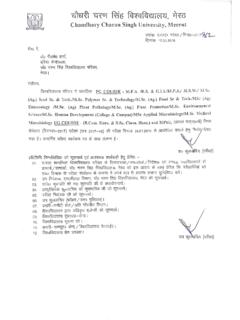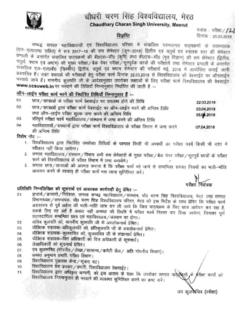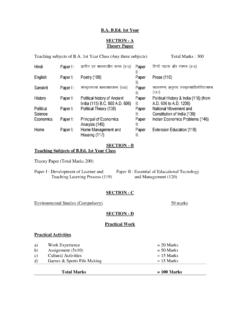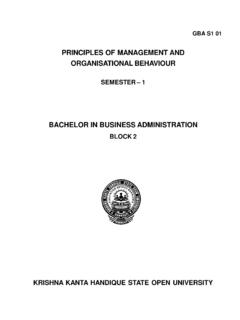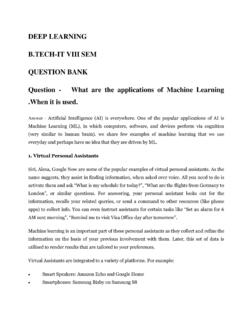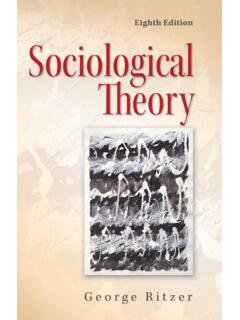Transcription of Electron Spin Resonance Spectroscopy
1 Electron Spin Resonance SpectroscopyNAZIA TARANNUM2 ESR Spectroscopy Electron Spin Resonance Spectroscopy Also called EPR Spectroscopy Electron Paramagnetic Resonance Spectroscopy Non-destructive technique Applications Oxidation and reduction processes Reaction kinetics Examining the active sites of metalloproteins3 What compounds can you analyze? Applicable for species with one or more unpaired electrons Free radicals Transition metal compounds Useful for unstable paramagnetic compounds generated in situ Electrochemical oxidation or reduction456 Energy Transitions ESR measures the transition between the Electron spin energy levels Transition induced by the appropriate frequency radiation Required frequency of radiation dependent upon strength of magnetic field Common field strength and T and 35 GHz Microwave regionBasic Principle of ESR78 What causes the energy levels? Resulting energy levels of an Electron in a magnetic field910111213 SpectraWhen phase-sensitive detection is used, the signal is the first derivative of the absorption intensityPhase-Sensitive detectors are used in EPR1415 Describing the energy levels Based upon the spin of an Electron and its associated magnetic moment For a molecule with one unpaired Electron In the presence of a magnetic field, the two Electron spin energy levels are:E = gmBB0 MSg= proportionality factormB= Bohr magnetonMS= Electron spin B0= Magnetic field quantum number (+ or - )16 Proportionality Factor Measured from the center of the signal For a free Electron For organic radicals Typically close to free- Electron value For transition metal compounds Large variations due to spin-orbit coupling and zero-field splitting FactorMoO(SCN) (acac) (anthracene) (anthracene) (acac) , N.
2 M. Principles of Electron Spin Resonance ; Ellis Horwood: Chichester, Value and the factors affecting it18g is the tensor quantity and it is the measure of intrinsic magnetic moment of Electron . It is unitlessIts also called asZeeman splitting factorSpectroscopic splitting factorLande s splitting factorGyromagnetic ratioFactors affecting g19 Thevalueofgisnotconstantbutitdependsupon thetypeofspeciescontainingunpairedelectr ons. Orientationofmolecule anisotropy(electronicmomentsarealignedin parallelorantiparalleldirectioninpresenc eofmagneticfield).2021 Shifting of g value in transition metal complexes22In transition metals shifting takes place due to orbital degeneracy and spin orbital couplingWhen the metal orbitals containing unpaired electrons mix with empty ligand orbitals then there is negative shift whereas when it mixes with filled ligand orbitals then there is positive Interactions EPR signal is split by neighboring nuclei Called hyperfine interactions Can be used to provide information Number and identity of nuclei Distance from unpaired Electron Interactions with neighboring nucleiE = gmBB0MS+ aMsmIa= hyperfine coupling constantmI= nuclear spin quantum number Measured as the distance between the centers of two signals26 Which nuclei will interact?
3 Selection rules same as for NMR Every isotope of every element has a ground state nuclear spin quantum number, I has value of n/2, nis an integer Isotopes with even atomic number and even mass number have I= 0,and have no EPR spectra 12C, 28Si, 56Fe, .. Isotopes with odd atomic number and even mass number have neven 2H, 10B, 14N, .. Isotopes with odd mass number have nodd 1H, 13C, 19F, 55Mn, ..27 Hyperfine InteractionsInteraction with a single nucleus of spin Ebsworth, E. A. V.; Rankin, David W. H.; Cradock, Stephen Structural Methods in Inorganic Chemistry; CRC Press: Boca Raton, Interactions Coupling patterns same as in NMR More common to see coupling to nuclei with spins greater than The number of lines:2NI+ 1N= number of equivalent nucleiI= spin Only determines the number of lines--not the intensities29 Hyperfine Interactions relative intensities determined by the number of interacting nuclei If only one nucleus interacting All lines have equal intensity If multiple nuclei interacting Distributions derived based upon spin For spin (most common), intensities follow binomial distributionThe hyperfine effect The magnetic field experienced by the unpaired Electron is affected by nearby nuclei with non-zero nuclear spinWeil, Bolton, and Wertz, 1994, Electron Paramagnetic Resonance , New York: Wiley splitting of EPR spectra The magnitude of the splitting and the number of lines depend upon.
4 The nuclear spin of the interacting nucleus # of lines = 2n(I + ) so I = gives 2 lines, etc. The nuclear gyromagnetic ratio The magnitude of the interaction between the electronic spin and the nuclear spin Magnitude of the splitting typically decreases greatly with increasing numbers of bonds between the nucleus and unpaired electron10 GaussNo hyperfine1 I=1/2 nucleus (1H)1 I=1 nucleus (14N)2 identical I=1/2 nuclei1 I=5/2 nucleus (17O)Hyperfine splittings are additive1 N, = Ga1N, = G, 1H, = Gaa1N, = G, 1H, = Gaa34 relative Intensities for I= NRelative Intensities0111 : 121 : 2 : 131 : 3 : 3 : 1 41 : 4 : 6 : 4 : 1 51 : 5 : 10 : 10 : 5 : 1 61 : 6 : 15 : 20 : 15 : 6 : 1 35 relative Intensities for I= 36 Hyperfine Interactions Example: VO(acac)2 Interaction with vanadium nucleus For vanadium, I= 7/2 So,2NI+ 1 = 2(1)(7/2) + 1 = 8 You would expect to see 8 lines of equal intensity37 Hyperfine InteractionsEPR spectrum of vanadyl acetylacetonate38 Hyperfine Interactions Example.
5 Radical anion of benzene [C6H6]- Electron is delocalized over all six carbon atoms Exhibits coupling to six equivalent hydrogen atoms So,2NI+ 1 = 2(6)(1/2) + 1 = 7 So spectrum should be seven lines with relative intensities 1:6:15:20:15:6:139 Hyperfine InteractionsEPR spectrum of benzene radical anionESR of 1,4 Benzosemiquinone radical anion402NI+ 1 = 2(4)(1/2) + 1 = 5 ESR spectrum of Naphthalene41It has two sets of equivalent protons =4 =42NI+ 1 = 2(4)(1/2) + 1 = 5 ESR Spectrum of Anthracene42It has three sets of equivalent protons =4 =4 = 22NI+ 1 = 2(4)(1/2) + 1 = 52NI+ 1 = 2(2)(1/2) + 1 = 343 Hyperfine Interactions Coupling to several sets of nuclei First couple to the nearest set of nuclei Largest avalue Split each of those lines by the coupling to the next closest nuclei Next largest avalue Continue 2-3 bonds away from location of unpaired electron44 Hyperfine Interactions Example: Pyrazine anion Electron delocalized over ring Exhibits coupling to two equivalent N (I= 1)2NI+ 1 = 2(2)(1) + 1 = 5 Then couples to four equivalent H (I= )2NI+ 1 = 2(4)(1/2) + 1 = 5 So spectrum should be a quintet with intensities 1:2:3:2:1 and each of those lines should be split into quintets with intensities 1:4:6:4:14546 ZERO FIELD SPLITTINGS plitting even in the absence of magnetic field 4748 Kramer s Degeneracy Asthenumberofunpairedelectronincreasesfr om0to2,zfsoccurswhichgiverisetofinestruc tureinESRspectrum.
6 IfevennumberofunpairedelectronthenMs=049 Spin Hamiltonian50 Energy levels have been represented in terms of Hamiltonian, as Electron spin Resonance (ESR) is concerned with Electron & nuclear spin, the scheme of energy levels is called as spin hamiltonian (Hs) of ESR spectra: Itdecidesthesiteofunpairedelectrons. Thenumberoflinecomponentsdecideaboutthen umberandtypeofnucleipresentintheneighbor hoodoftheoddelectron. IftheelectricfieldisnotsphericalthentheE SRspectrumisanisotropic,ietherotationoft hesampleshiftstheESRspectrum. Fromthisthegvaluecanbemeasuredbycomparin gthepositionofthelinewiththatofstandards ubstance. of ESR Spectroscopy : Study of Free radicals Eveninverylowconcentrationsalsowecanstud ythefreeradicalsbyusingESRspectroscopy. Structureoforganicandinorganicfreeradica lscanbeidentified. Investigationofmoleculesinthetripletstat e. Spinlabelgivestheinformationaboutpolarit yofitsenvironment. StructuralDetermination IncertaincasesESRprovidestheinformationa bouttheshapeoftheradicals.
7 Reaction Velocities and Mechanisms Study of inorganic compounds Study of catalysts determination of oxidation state of a metal. Analytical applications: determination of Mn2+ determination of vanadium. determination of poly nuclear hydrocarbon. Biological applications: The presence of free radicals in healthy and diseased conditions. Functioning of most of the oxidative enzymes can be does the spectrometer work?Instrumentation Source Circulator or Magic -T Sample Cavity Magnet System Crystal Detector Auto amplifier and Phase sensitive Detector Oscilloscope and Pen RecorderSource: : Itisanonreciprocaldevicewhichminimizesvi brationsinthefrequencyofmicrowavesproduc edbyKlystronoscillator. Thevariationsoccurinthefrequencyduetothe backwardreflectionsintheregionbetweenthe Klystronandcirculator. Isolator is a strip of ferrite meter Itisfixedinbetweentheisolatorandattenuat ortoknowthefrequencyofmicrowavesproduced byKlystronoscillator. : Attenuatorisusedtoadjustthelevelofthemic rowavepowerincidentuponthesample.
8 T or Circulator: Cavity: Thisresonantcavitywhichcontainsthesample iscalledtheheartofESR. Itisconstructedinsuchawaytomaximizetheap pliedmagneticfiledalongthesampledimensio n. System: Thesamplecavityisplacedbetweenthepolepie cesofanelectromagnet Thisprovidesahomogenousmagneticfieldandc anbevariedfromzeroto500gauss. Detectors: The most commonly used detector is a silicon crystal which acts as a microwave rectifier. This converts microwave power into a direct current and Pen Recorder Spectrometer:Working: TheKlystronoscillatorissettoproducemicro waves. Afterpassingthoughtheisolator,wavemetera ndattenuatorthemicrowavesareenteredintot hecirculatoronmagicT Thenitreachesthedetectorwhichactsasarect ifier, Ifthemagneticfieldaroundtheresonatingcav ityhavingthesampleischangedtothevaluereq uiredfortheresonance,therecorderwillshow anabsorptionpeak. Ifthemagneticfieldissweptslowlyoveraperi odofseveralminutes,therecorderwillshowth ederivativeofthemicrowaveabsorptionspect rumagainstmagneticfieldasshownbelow:Magn etic fieldMagnetic fieldDerivative signalIntensitypeakPresentation of ESR Spectrum: The ESR spectrum is obtained by plotting intensity against the strength of a magnetic field.
9 ThebetterwayistorepresentESRspectrumasad erivativecurveinwhichthefirstderivative( slope)oftheabsorptioncurveisplottedagain stthestrengthofthemagneticfield The total area covered by either the absorption or derivative curve is proportional to the number of unpaired electrons in the sample. Inordertofindoutthenumberofelectroninanu nknownsample,comparisonismadewithastanda rdsamplehavingaknownnumberofunpairedelec tronsandpossessingthesamelineshapeastheu nknown. Themostwidelyusedstandardis1,1-diphenyl- 2-picrylhydrazylfreeradical(DDPH)72 Conclusions Analysis of paramagnetic compounds Compliment to NMR Examination of proportionality factors Indicate location of unpaired Electron On transition metal or adjacent ligand Examination of hyperfine interactions Provides information on number and type of nuclei coupled to the electrons Indicates the extent to which the unpaired electrons are delocalizedTO SUM UP73 WaterandalcoholarenotsuitablesolventsinE SRbecoztheystronglyabsorbinmicrowaveregi on InESRtransitionsoccurinmicrowaveregionan dinNMRthetransitionsoccurinrfregion.
10 Theintensityofabsorptionlineisproportion altothenumberofunpairedelectronsinESRspe ctrum. InNMRspectroscopy,thetwodifferentenergys tatesareproducedasaresultofalignmentofnu clearspinrelativetotheappliedfieldwherea sinESRspectroscopy,thetwodifferentenegys tatesareproducedduetoalignmentofelectron icfiel
